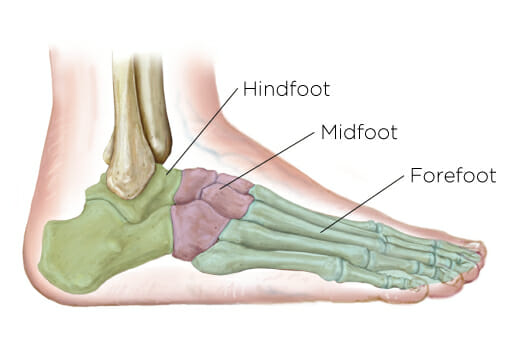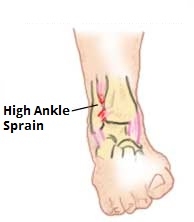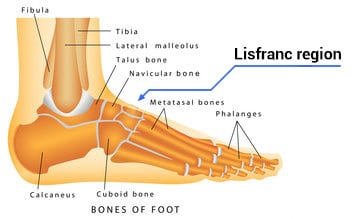
High Ankle Sprain (Syndesmotic Sprain)
Last Updated on August 13, 2024 by The SportsMD EditorsA high ankle sprain is a significant injury and can sideline an athlete much longer than a typical ankle sprain. Ankle injuries are one of the most common injuries in sports constituting approximately 10% of all acute injuries that are treated by physicians. A sprained ankle can occur on the lateral side of the ankle which is (most common), the medial side of the ankle (least common) or can occur as a syndesmotic sprain when the ligaments between the distal tibia and fibula are injured, also known as a high ankle sprain.
What is a syndesmosis joint?
A high ankle sprain usually occurs in combination with medial ligament injuries and/or distal tibia/fibula fractures. They are significant injuries and can sideline an athlete much longer than a typical ankle sprain. In the lower leg/ankle, the distal tibia/fibula joint is considered a syndesmosis joint because the tibia and fibula are held together by an interosseous membrane that extends the length of the bones.
This membrane secures the two bones and helps stabilize the tibia and fibula to the talus forming the talocrural joint (primary ankle joint) also known as the ankle mortise. This joint is responsible for dorsiflexion and plantarflexion (movements up and down of the foot).
The distal tibia and fibula are held tightly together by the syndesmosis membrane, and the anterior and posterior tibiofibular ligaments. A syndesmotic sprain or high ankle sprain is an injury to the distal tibiofibular syndesmosis with possible disruption of the distal tibiofibular ligaments and interosseous membrane.
Syndesmosis ruptures are also associated with specific types of ankle fractures. Distal fibula fractures are associated with syndesmosis ruptures 50% of the time and are usually caused by external rotation of the foot/ankle.
However, a certain type of fibular fracture known as type C fibular fractures almost always involve syndesmosis injuries and may include a high fibula fracture, an interior inferior tibiofibular ligament rupture, and a rupture of the interosseous membrane. These types of fractures are considered unstable and most likely will need surgical intervention to stabilize the joint.
Signs and symptoms of a high ankle sprain
 The difficulty with these types of injuries is that they are often associated with severe lateral or medial ankle sprains or fibular fractures. However, in an isolated high ankle sprain, the athlete or person may experience the following symptoms:
The difficulty with these types of injuries is that they are often associated with severe lateral or medial ankle sprains or fibular fractures. However, in an isolated high ankle sprain, the athlete or person may experience the following symptoms:
• Point tenderness over anterolateral tibiofibular joint (above lateral malleolus)
• Pain with weight-bearing
• Pain with passive dorsiflexion
• Pain with passive external rotation
• Mild to moderate swelling in lower leg above ankle
If a syndesmotic ankle injury is suspected, the athlete’s lower leg, ankle, and foot should be immobilized and the athlete transported for immediate emergency medical evaluation.
Diagnosing a high ankle sprain
Because syndesmotic sprains can be associated with lateral ligament injuries, medial ligament injuries, and fractures of the fibula, x-rays of the lower leg and ankle are necessary. If the athlete has a total syndesmosis rupture, separation will be evident in the x-ray between the tibia, fibula, and talus.
https://twitter.com/2PTsNaBagOChips/status/1120843223432192003
In addition to x-rays, the sports medicine physician may also order stress x-rays or a magnetic resonance imaging (MRI). The MRI is a better diagnostic tool for looking at soft tissue injuries including ligament and interosseous membrane tears.
Who gets a high ankle sprain?
The incidence of high ankle sprains has been reported to be as much as 10% of all ankle sprains. However, many times they go undiagnosed because the focus is often on injuries to the more commonly sprained lateral ankle ligaments.
Ankle injuries occur commonly in sports in which quick changes of direction are required (i.e., soccer, handball) or in which athletes need to jump and land in and around multiple athletes (rebounding in basketball, blocking in volleyball).
Syndesmotic injuries can also occur in skiing accidents when the foot is stabilized in the boot and the body rotates as during a fall when the bindings do not release. The force of the body twisting initially tears the ankle ligaments. However, if the force continues, the interosseus membrane can be torn up the length of the lower leg.
Causes of high ankle sprain
The more serious ankle injuries often occur when an athlete lands on the foot of another athlete when returning back to the ground from a jump. The weight of the athlete plus the force of gravity combine to create a force higher than the tensile strength of the ankle ligaments, ankle bones, and interosseous membrane can withstand.
The distal anterior and posterior tibiofibular ligaments are torn with extreme external rotational or forced dorsiflexion (toes to anterior lower leg) in combination with severe ankle sprains.
How can I help prevent a high ankle sprain?
Because a high ankle sprain is a severe ankle injury, preventing a syndesmotic injury can follow the same principles as preventing a regular ankle injury. The following can be done by the athlete to try to reduce the incidence of ankle injuries:
• Maintain strong ankle muscles by strengthening them regularly with ankle band exercises performing 3 sets of 10 repetitions in all four ankle directions.
• Wear proper, well-fitted shoes appropriate for the sport.
• Consider wearing a brace to prevent an injury or taping/bracing the ankle for extra support after returning to sport from an ankle injury.
There are many different types of ankle braces available and on the market. For an ankle brace to be effective, the brace should be fitted with a medial and lateral support (strong plastic or similar material) that extends up the sides of the brace. Ankle braces made of only neoprene or other soft material do not provide enough support to prevent additional injuries.
Another consideration for the athlete is to make sure that the brace fits comfortably into the athletic shoe. Some braces that are rigid may not fit comfortably into every athletic shoe. The athlete should try on different braces to ensure that the fit is comfortable and that the brace has additional medial/lateral supports to prevent further injury.
High ankle sprain treatment
Although the treatment for a high ankle sprain follows the same principles as the treatment for a regular ankle sprain, the time frame may be much longer. Partial syndesmosis ruptures are treated with immobilization in a walking cast or boot for a minimum of two weeks and longer if necessary depending on the severity of the injury.
Initially, sports injury treatment using the P.R.I.C.E. principle – Protection, Rest, Icing, Compression, Elevation can be applied to a high ankle sprain.
High Ankle Sprain Surgery
Total ruptures may require high ankle sprain surgery followed by cast immobilization for up to eight weeks and then partial weight bearing for an additional three to four weeks.
After immobilization, traditional therapy can be started focusing initially on improving the range of motion of the ankle followed by strengthening exercises, and neuromuscular training (balance training).
Speak to Sports Specialized Provider within minutes for $29.
 How severe is your injury? Do I need to see a doctor or can this be managed at home? What should be my treatment plan? SportsMD Virtual Urgent Care is available by phone or video anytime, anywhere 24/7/365. Learn more via SportsMD’s Virtual Urgent Care Service.
How severe is your injury? Do I need to see a doctor or can this be managed at home? What should be my treatment plan? SportsMD Virtual Urgent Care is available by phone or video anytime, anywhere 24/7/365. Learn more via SportsMD’s Virtual Urgent Care Service.
High ankle sprain taping
High-ankle sprains respond extremely well to taping. For more severe, acute, high-ankle sprains, aggressive stabilization with rigid tape works very well. With more mild sprains, a simple kinesiology-tape technique is very effective.
High ankle sprain Braces
High ankle sprain recovery time
It is important to understand that because the structures involved in a high ankle sprain can lead to instability of the primary ankle joint, rehabilitation and total healing take much longer recovery time than a traditional ankle sprain. This is the point that coaches need to understand. ALL ANKLE SPRAINS ARE NOT THE SAME.
Recovery from a mild ankle sprain may take several days whereas recovery from a severe high ankle sprain may take several months. In contrast, recovery from a partial syndesmosis rupture may take several months whereas recovery from a full rupture may take up to six months.
The goal of rehabilitation is to return the athlete to sport safely. Returning an athlete too early can cause further injury to the damaged tissue. In the case of a high ankle sprain, returning an athlete too early may cause an unstable ankle and may cause osteoarthritis in the joint over time.
Because every athlete’s injury is unique, each athlete should be functionally tested prior to being released to return to play rather than following a timetable out of a book. For this type of injury, the athlete may return to play after being released by a sports medicine professional and after achieving the following:
• Full range of motion of the injured ankle as compared to the uninjured ankle
• Full strength of the injured ankle as compared to the uninjured ankle
• Full power (ability to jump) off of the injured ankle as compared to the uninjured ankle
• Ability to perform functional skills relative to the athlete’s sport
• Ability to jog, run, and sprint without pain
More on High Ankle Sprain Recovery Time
FAQs
Q: How long does it take for high ankle sprain to heal?
A: Recovery from a mild high ankle sprain may take several weeks and recovery from a severe high ankle sprain may take several months. It’s important to note the all ankle sprains are not the same. High ankle sprains take longer to heal.
Q: Can you walk on a high ankle sprain?
A: Although it’s possible to walk on a high ankle sprain it isn’t recommended as it can delay the healing process and increase your risk for complications. Depending of the level of severity a doctor may perscribe a brace or even a boot to help with recovery.
Q: How serious is a high ankle sprain?
A: A high ankle sprain is a significant injury and can sideline an athlete much longer than a typical ankle sprain.
Q: What does high ankle sprain feel like?
A: Patients who have a high ankle sprain will usually will have pain just above the ankle, and intense pain when ascending or descending the stairs or flexing the ankle upwards.
LeBron responds after going out indefinitely with a high ankle sprain. pic.twitter.com/oVGdw81Ren
— ESPN (@espn) March 21, 2021
References
Bahr, R. & Maehlum, S. (2004). Clinical Guide to Sports Injuries. Human Kinetics: Champaign, IL.
Brukner, P. & Khan, K. (2002). Clinical Sports Medicine. (2nd Ed.). McGraw Hill: Australia.
Rouzier, P. (1999). The Sports Medicine Patient Advisor. SportsMed Press: Amherst, MA.


